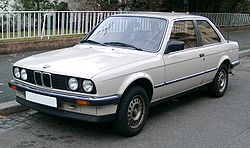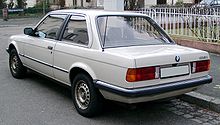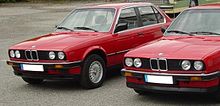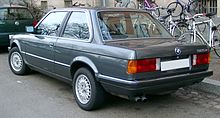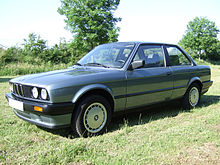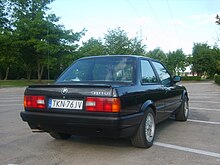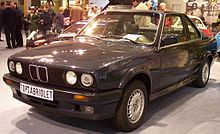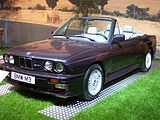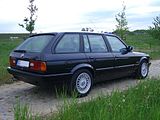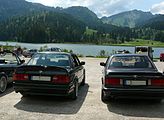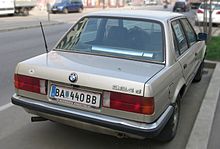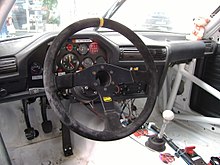BMW E30
| BMW | |
|---|---|
|
BMW 318i (1985–1987)
|
|
| E30 | |
| Sales designation: | 3 series |
| Production period: | 1982-1994 |
| Class : | Middle class |
| Body versions : | Sedan , station wagon , convertible |
| Engines: |
Otto engines : 1.6–3.2 liters (55–175 kW) Diesel engines : 2.4 liters (63–85 kW) |
| Length: | 4325-4360 mm |
| Width: | 1645-1680 mm |
| Height: | 1365-1380 mm |
| Wheelbase : | 2565-2570 mm |
| Empty weight : | 990-1330 kg |
| Previous model | BMW E21 |
| successor | BMW E36 |
With the factory code BMW E30 vehicles are the second 3-series from BMW called. The Z1 Roadster model derived from this series had the same factory code.
The E30 was produced in far more variants than its predecessor, the BMW E21 , which was only offered with two doors . The second 3 Series came on the market at the end of 1982 and was also available as a four-door model from September 1983. In autumn 1985 - 670,000 E30s were sold by August 1985 - the full convertible (without roll bar ) and the first M3 were presented. As the second BMW diesel car after the 524td diesel model presented in 1983, the smaller 324d was added to the BMW range in 1985. To the great facelift in September 1987 was followed by a station wagon variant to the already hatchback model of the BMW 02 used names Touring .
The E30 model was manufactured 2.34 million times in the Munich and Regensburg plants.
Model history
The E30 series replaced the vehicles of the first 3 series E21 in November 1982 . The design of the first 3 series comes from Paul Bracq and was further developed in the E30 under Claus Luthe . The executive exterior designer was Boyke Boyer . Production (not delivery) of the first two-door models (323i) began in December 1981, the 320i from January 1982 and the 316 / 318i from March 1982. The four-door sedans were manufactured from January 1983.
The Baur Topcabriolet, also based on it, was part of the model range from the beginning of 1983 until the end of production of the two-door sedans. In January 1986, the range was expanded to include the convertible with a fully retractable top and without a roll bar, and in 1987 the "touring" station wagon was launched. The first generation of the BMW M3, which has been available since 1986 and was later used successfully in the DTM, is characterized by low numbers.
On the drive side, it initially remained largely with the engines known from the E21 . In the six-cylinder engines, however, the mixture preparation was changed: the six-cylinder variants now featured the Bosch L-Jetronic series, the predecessor the 320 was only available with a carburettor, the 323i had a Bosch K-Jetronic . With the 325e (e pronounced eta ), a particularly high-torque and comparatively economical variant was introduced parallel to the BMW 525e E28 . In addition, with the development of the 324d and the 324td available two years later, a diesel engine with or without a turbocharger , also parallel to the BMW 524d / 524td E28 , was put into production for the first time in BMW history . Animated by the success of the competition, especially Audi with its quattro drive , BMW developed an all-wheel drive , which was then used for the first time in the company's history in a civilian vehicle in 1985 on the 325iX (from 1937 there was already the light standard Wehrmacht car of the type BMW 325 an all-wheel drive BMW).
Externally, the four- and six-cylinder models or models with a displacement of two liters or more could no longer be distinguished as clearly as with the predecessor E21 , since all E30s now had twin headlights as standard. The only, if not very noticeable, distinguishing feature was the different design of the rear silencer, which was freely visible on the models up to 08/1987 due to the smaller rear apron. The four-cylinder with the M10 engines (316 66 kW, 316i 75 kW, 318i 75/77 kW) were equipped with a single-flow round cross-section, the six-cylinder (320i 92 kW, 323i, 325e 90 kW) received a larger, oval one and also single-flow rear silencer. Up to the end of production, the later six-cylinder units were provided with identical but double-flow systems. With the use of the M40 / M42 motors, the only difference to the M20 variants was a single to double-flow system with different pipe diameters, with the rear silencer being almost identical in size.
In the interior, the differences, especially in the fabric covers, became greater, if not serious. In contrast to the one-piece door panels entirely covered with artificial leather, the six-cylinder models were given others with a fabric or velor insert. In comparison, the seat cushions were more complex and a little higher quality. The seat cheeks of the six-cylinder were covered with smooth velor fabric and the seat center panels with structured fabric, while the four-cylinder models were made of simpler, but also high-quality fabrics with a uniform pattern. In addition, the 6-cylinder models had a tachometer with a digital clock (later an analog clock) in the center console as well as the "Check Control" over the inside mirror. This equipment feature, which was integrated in the headliner with an additional black cover and smaller black sun visors, was used to monitor important electrical vehicle functions and the fluid levels.
The BMW E30 was manufactured as a two- and four-door sedan until April 1991. Production of the convertible ended in April 1993. The Touring was the last variant of the E30 series to be offered until April 1994.
In South Africa, production of the right-hand drive two- and four-door models did not end until February 1992.
The successor model presented in September 1990 received the factory code E36 .
Facelift
1985
The first facelift was made in September 1985. The most obvious external innovation was the change in the front apron, which was now made in one piece and vertically. The front spoiler, which is slightly shaped downwards in the direction of travel, was finally pulled further under the engine with a gentle curve. Until then, the two-part front apron with the associated smaller spoiler formed an escape to the headlight grille. The 195 / 60R14 tires were replaced by the 195 / 65R14 format, which is larger in cross-section. The rockfall protection that is now consistently applied to the rear panel below the bumper is relatively inconspicuous, previously on the right and left only from the wheel arch to just above the body joint of the rear panel / side wall. Changed upholstery fabrics found their way into the interior, the difference between the four-cylinder and the six-cylinder was now smaller, it consisted only of differently patterned seat center panels, and smooth velor was always used on the outside. In addition, the “Pepita” fabric upholstery was introduced, which was available for all variants. The differences in the door panels remained. The most striking changes are the belt guides at the back. The redirection on the C-pillar was omitted and the lap belt with the brackets for the belt locks was now mounted the other way around. The parcel shelf has been adapted to the rear seat bench, which has been minimally changed in the upper area, just like for the now flat three-point seat belts. These changes in the interior remained until the end of production of the sedans.
1987
In September 1987, BMW introduced in the two- and four-door sedan, a big facelift (face lift) through the Cabriolet was not until 1990 the external facelift that whereas M3 every which way until the end of production in 1991 was outwardly further built as Vorfaceliftvariante, except for the headlights, which were converted to lens technology at the same time as the facelift of the convertible. In addition, the Touring station wagon was initially available as the 320i and 325i, while the 325e model was no longer available.
The most noticeable changes were a newly designed front apron , the chrome bumpers gave way to the more voluminous and plastic-made anthracite-colored bumpers, which were painted in the body color on request (part of the "Shadow-Line" special equipment, see below, otherwise for an extra charge on special request) , whereby the bumper inserts generally remained black. The bumpers now withstood bumps up to 4 km / h undamaged. Their mountings, called impact boxes because of their shock-absorbing functionality, protect the vehicle frame from deformation up to 15 km / h. The chrome trim, for example on the front and rear windows and around the door windows (two-door rear around the rear window on the side) gave way to black plastic parts or black-coated aluminum profiles. The side bumper strips were now one-piece and without a chrome strip. The rain gutter and the window slot strips remained in chrome.
The rear lights and the rear apron have been enlarged. The new DE main headlights had reflectors in a triple ellipsoid shape. The rear wheel cutout has been reduced in size and given the shape that has been found on the convertible since production began. The tank volume grew from 55 l to 64 l (6-cylinder sedan only) or 62 l (works convertible and 318i Edition Executive). Since the facelift, all petrol engines have been equipped with a regulated catalytic converter as standard .
The interior remained largely unchanged, the type of seat cover was retained, only the colors in their nuances and names were changed. New upholstery fabrics for the interior and exterior paintwork that differed from the series were offered for various "edition models" (Edition Executive for the sedans 318i – 325i , last edition for sedan / convertible 325i , design edition for convertible 318i and touring 316i / 318i ) to promote sales until the end of production of the respective body variant. For the M3 and 318is , special fabric / color combinations were available. The range of optional equipment has been expanded.
In the case of the export models for the US market, no model updates were initially carried out. In 1988 they also received new, shortened bumpers, but they were chrome-plated. In 1989 plastic bumpers were also introduced here.
Body styles
| Factory code | Start of production | End of production | |
|---|---|---|---|
| two-door sedan | E30 / 2 | December 1981 | April 1991 |
| four-door sedan | E30 / 4 | January 1983 | April 1991 |
| Baur top convertible | E30 / 2Cab (based on two-door sedan, series) E30 / 4Cab (based on four-door sedan, prototype) |
February 1983 | April 1991 |
| Cabriolet | E30 / 2C | July 1985 | April 1993 |
| M3 Cabriolet | E30 / 2SC | June 1988 | June 1991 |
| M3 | E30 / 2S | February 1986 | December 1990 |
| Touring ( station wagon ) | E30 / 5 | July 1987 | April 1994 |
| Z1 Roadster | E30 / Z (pilot series 80 pieces); Series: Z1 | July 1988 | June 1991 |
| All-wheel drive variants (iX) | E30 / 16 | February 1985 | February 1991 |
Baur top convertible
From the beginning of 1983, the BMW E30 was converted into a convertible in small numbers exclusively as a two-door model by the Stuttgart-based company Baur and sold by the BMW dealer network. All petrol engines could be chosen. The Baur TC (compare its predecessor BMW E21 Baur TC or BMW 02 Baur TC) was not a full convertible. So the side window frames and a roll bar remained. The sturdy roof section over the front seats could be opened like a targa roof, the rear roof area could be opened like a landaulet . In 1988 Baur produced a top convertible based on the four-door sedan as a one-off. The vehicle, which was never officially presented, was in the company's own vehicle exhibition for several years and is now owned by a private BMW collector.
Cabriolet
After 15 years without a convertible in the BMW model range, the open-top BMW 325i was presented at the 1985 IAA . Later, the 320i (from 1987) and the 318i (with the facelift to the 91 model) rounded off the convertible range at the bottom.
In September 1988 the M3 Cabrio appeared, which was built only 786 times between June 1988 and June 1991. In the USA the 318i Cabrio was delivered with the four-valve M42 engine (construction period July 1990 to December 1992). To make the cabriolet torsion-resistant, the body, sills and the window frame were reinforced. This increased the weight of the open vehicle by around 125 kg compared to its closed counterpart. The soft top could later also be lowered electrically (on the M3 series) (initially electro-hydraulic, later electric motor) and disappeared under a flat convertible top flap. Also available was a hardtop with vinyl cover from BMW and a hardtop from Wiesmann that could be painted in the same color as the car .
In the six-cylinder versions from 320i onwards, the bumpers and exterior mirrors were painted in the same color as the car from the model update on the body in autumn 1990.
M3
The BMW M3 initially served as the base vehicle for homologation in Group A and became one of the most successful racing touring cars of all time, for example in the DTM . The vehicle was developed and produced by BMW M GmbH , a subsidiary of BMW.
The BMW M3 was available as a two-door sedan and as a convertible. The wheelbase was shortened by 5 mm compared to the other versions. For both variants, the body has exhibited fenders for the improved and widened chassis with a larger brake system and 5-hole hubs instead of the 4 and only on the sedan a rear window attachment with a flat rear window including a raised plastic trunk lid with spoiler. The body changes corresponded to the zeitgeist and the main reason, especially in the sedan, resulted in an improvement in aerodynamics. The engine used was a four-cylinder four-valve engine with the designation S14 derived from the engine block of the BMW M10 and cylinder head of the six-cylinder engine BMW M88 originally used in the BMW M1 (with 2302 cm³ 143–158 kW (195–220 hp), later 2453 cm³ (175 kW / 238 PS in Sport Evolution 2)). The concept for this engine comes from Paul Rosche , also known as "Nocken-Paule", who was originally only transferred to camshaft development due to a lack of staff. The high-revving engine initially developed 147 kW (200 hp) without cat. And from 1987 with cat. 143 kW (195 hp). In the then DTM as a touring racing car even up to 276 kW (375 PS).
In export models for the Italian market, this engine was reduced to two liters due to the local tax laws and offered as a 320is with 141 kW (192 hp) in the normal E30 body without the chassis-specific changes to the M3 . The BMW 320iS was built around 3,600 times, of which around 1,100 were built as a 4-door sedan, which could optionally be equipped with the M-Technik package 2.
Rear view with the concise rear wing
Touring
The station wagon variant (internal E30 / 5) based on the four-door sedan was presented in September 1987 at the beginning of the 1988 model year with the second facelift.
In contrast to its predecessor, the Touring of the 02 series, the 3 Series Touring was enthusiastically received by the target group. It was available as the 320i, 325i and 325ix, later followed by the 324td, 318i and also the small 316i. It is characterized by an almost level cargo area with a fine carpet and completely covered wheel arches with integrated storage compartments and boxes for the sound system. The back seat was split in half and foldable. A load compartment cover was part of the equipment, as was a wiper / washer system for the rear window. The wide taillights were fixed, the tailgate only reached the width of the license plate down to the level of the cargo space, which sometimes made loading and unloading difficult.
In the last few model years, the Touring range was rounded off by the Design Edition special models.
Production of the first 3 Series Touring ended in the spring of 1994.
Special series
320i Edition "S"
The 320i Edition "S" was built in 1985 as a limited special model. It was a diamond black metallic painted 2-door sedan with manual transmission.
The scope of equipment included:
- A front spoiler and a rear spoiler
- Shadowline, i.e. all chrome parts, except for the kidney grille, rain gutter and window sill, were blackened, even the radio antenna
- Green thermal insulation glazing
- Steel crank roof
- Sport leather steering wheel
- Leather gear knob
- Interior in anthracite
- M-Technic chassis with gas pressure shock absorbers and harder stabilizers
The models could be recognized by the specially polished 14-inch alloy wheels in the "Styling E30" design with 195/65 tires and the two decorative stripes on the side at the height of the "light edge". As a novelty, the revised 320i engine with 129 hp and 174 Nm was installed instead of the 125 hp engine.
318i edition
The 318i edition model was launched in May 1987 at the end of the “chrome era”. It was initially available as a two- and four-door sedan (at the usual surcharge for metallic paint) in the metallic colors salmon silver, dolphin, diamond black and, from June, also in the plain colors alpine white and vermilion. All chrome parts, except for the kidney grille, rain gutter and window sill, were blackened. The bumpers and exterior mirrors were painted in body color. In addition, a front spoiler was fitted in the same color as the car and a rear spoiler, which was always painted black, regardless of the exterior color. The standard chassis was replaced by the M-Technic chassis. Green heat protection glazing all around was part of the equipment package as well as the 3-spoke leather sports steering wheel, a leather gear knob, electrically adjustable right exterior mirror, light alloy wheels 6x14 ET35 in BMW design ("manhole cover") with 195 / 65R14 tires and a tachometer with consumption display. The interior was anthracite. The package price was DM 2,200.
Edition Executive
At the end of the production of two- and four-door sedans, edition equipment was offered for the 318i, 320i, 325i, 325iX and 324td, which was characterized by numerous built-in extras. If the interior trim color is chosen accordingly, the color-matched interior fittings that are only used here stand out, which were optionally processed in the colors silver or indigo (instead of the "usual" black). In contrast to the series, or the interior color anthracite, the entire center console, the lower parts of the dashboard, the B-pillar trim, gear lever and handbrake bellows and, from 320i, the seat belts were also made in the same interior color. In the case of six-cylinder models, the belts were finally provided with a dark edge. The upholstery fabrics for the six-cylinder were only available in the so-called “pinstripe velor”, which was used on the seat center panels and the textile door inserts. 318i models had different seat upholstery fabrics with about 0.5 cm wide horizontal stripes across the middle section in anthracite or indigo, depending on the upholstery color. The side bolsters were covered with smooth velor and, from the 320i, the rest of the seat too. On the 318i, only the seats and the side bolsters were covered with it and, as is known from the standard models, the rest of it with black synthetic leather. The 6-cylinder petrol engine received a textile headliner, the 318 a headliner over the windshield (for 6-cylinder series because of check control). Externally, all models were the only post-facelift models that had the closed (318i, 320i) or the open oil cooler cover (324td, 325i, 325iX) fitted in the body color ex works. On all other models this cover was always black.
The scope of equipment included from 318i Shadow-Line, BMW light alloy wheels 6Jx14 with 195 / 65R14, green heat-insulating glass, fog lights, a black exhaust cover, central locking, higher-quality upholstery and the significantly upgraded, color-coordinated interior, sports leather steering wheel, radio BMW Bavaria C II, Cassette holder, outside temperature display, and the larger 62 l tank, otherwise only used in the six-cylinder. From the 320i, the equipment was enhanced with metallic paintwork, aerodynamic components painted in body color, BMW light alloy wheels 6J × 14 (324td), BMW light alloy wheels 6.5Jx14 in cross-spoke styling with painted wheel spider (325i also with a high-sheen rim edge), chrome-plated exhaust trims (except 324td) , Center armrest in the rear, radio BMW Bavaria C Reverse II, front electric windows, illuminated switch button emblem, automatic interior light, trunk lid trim and from 325i by electronic temperature control, for 325iX heating for the exterior mirrors including heated windscreen washer nozzles and driver's door lock as well as seat heating, ski bag and headlight washer system .
Design edition
In the last two years of construction, the Touring was only manufactured as the 316i and 318i and the Cabrio as the 318i and, in contrast to the standard models, was also offered with a particularly beautiful and extensive "Design Edition" option. This was characterized by special paintwork and an interior coordinated with the exterior color.
As early as 1991, the 318i Cabrio appeared in a design edition in the special colors neon green and neon blue. The seat center panels / door panels were designed in neon green mottled or neon blue mottled to match the exterior color. In addition, the vehicles were upgraded with the following special equipment ex works: light alloy wheels, cross-spoke styling with 205/55 R15 tires, M Technic leather sports steering wheel / leather gear knob and Shadowline. In this first design edition, the rim stars were also painted in the body color.
For the 1992 model year, the design edition was supplemented by the two additional colors mugello red and dayton purple and further upgraded with an expanded range of equipment (ABS, electric motorized top, M-Technic chassis, central locking).
At the end of 1992 there was the final edition of the 318i Design-Edition Cabrio with further improved equipment (Walknappa leather, bi-color, seat heating, fog lights, radio Bavaria C Reverse RDS) in the three colors mugello red, daytona violet and Mauritius blue with the corresponding colored seat centers in mugello red, dayton violet or tobago blue.
For the Touring, the paint finishes were mugello red, dayton violet metallic, Mauritius blue metallic, lagoon green metallic with corresponding interior colors and in addition mica black and sterling silver metallic where the four interior colors were freely selectable. The basis of the fabrics for the interior was an anthracite-colored cover, which was mottled red, purple, blue or green on the seat center panels. The piping between the black synthetic leather on the side and the anthracite-colored seat cheeks also had the corresponding basic color. The door panels were provided with the mottled fabric inserts used on the seat center panels in the manner known from the six-cylinder models. The scope of the design edition for the Touring included an airbag steering wheel with a leather rim (from 9/92 on all E30 series) and leather gear knob, sport seats, mechanical sliding and tilting roof, 15-inch aluminum rims in cross-spoke design from BBS with 205/55 R15 tires, heated exterior mirrors (heated driver's door lock and heated windscreen washer nozzles included), fog lights, central locking, rev counter and ZV for 316i (with 318i Touring series), radio BMW Bavaria CIII and headliner in anthracite.
325i Cabrio M-Technic Edition
In 1988 a special edition for the 325i convertible was launched, SA 791. This was available in the special paint finishes Macao Blue Metallic or Nogaro Silver Metallic and had full leather trim in soft nappa silver or black, with doors, door pockets, rear side panels, center console and sometimes the top compartment lid next to the seats in leather were related. The equipment was supplemented by an M Technic chassis, 15 ″ cross-spoke wheels, an electro-hydraulic convertible top operation, Shadow-line and M-Technic leather sports steering wheel II including a leather gear knob.
M Technic luxury edition
From June 1990 to October 1990, in addition to the M-Technic sports package, the 325i Cabrio was offered a significantly upgraded equipment package for a limited time (not limited in number). Often the terms first or last edition are used for this.
In addition to the special macao blue or sebring gray metallic paintwork, the scope of equipment also included full leather appointments (doors, door pockets, door handles, side panels, center console, ashtray, convertible top compartment lid, steering wheel baffle plate, handbrake bag) in soft nappa black or silver. The seat center panels of the seat covers are made in a "nappa textile weave structure". An electromechanical soft top operation, painted rim stars in nogaro silver, a trunk lid panel and door sills with M-Technic lettering rounded off this extensive option.
From March to October 91 there was another time-limited edition of this edition with identical features. In addition, the paint finishes lagoon green, Mauritius blue and calypso red metallic and lotus white as a third interior color were available.
In July 1992 a 3rd very small edition of this equipment package was delivered. There are 20 convertibles exclusively in alpine white II with lotus white equipment and should therefore be the smallest E30 special series ever.
The surcharge for the edition package was DM 14,300.
Equipment packages
Shadow-Line: This special equipment was introduced in Germany from the beginning of 1986. All chrome parts except the brand-specific kidney grille were kept black and mirrors and bumpers were painted in the same color as the car. The choice of colors was always limited with this option. The paint finishes available were initially 3 metallic colors: salmon silver, dolphin and diamond black. In 1988 alpine white II and vermilion extended this option. In 1989 salmon silver was replaced by sterling silver and vermilion was replaced by brilliant red. In 1991 dolphin silver was replaced by granite silver.
The models 318is, 320is two-door, M3 and the Touring (extended color selection for the Touring) were only available with "Shadow-line".
On special request, for models outside Germany and for almost all edition models, Shadowline was also combined with other colors.
Sports package: Until August 1987, a package with more sporty technology (M-Technic chassis, 14 ″ aluminum wheels) and a modified exterior design (front and rear spoiler in body color, shadow line, metallic paint in diamond black, salmon silver or dolphin, green colored glazing). From September 1987 this package was available as an option for the two- and four-door 320i and 324td sedans.
M Technic sports package: The “M Technic” sports package was available for the 325i sedan up to August 1987, consisting of front and rear aprons, side skirts and a somewhat more voluminous two-part rear spoiler with a plastic insert that was also painted, mounted under the bumpers and painted in the vehicle color . Further equipment details such as Shadow-Line (limited choice of colors, see above), M Technic sport leather steering wheel, 15 ″ light metal rims in cross-spoke design with 205 / 55VR15 tires, "M Technic" sports suspension, green heat-insulating glass, sports seats, headliner in anthracite, Leather gear knob and bellows, an interior mirror with map reading lights and an automatic interior light rounded off this extensive option.
From September 1987, the "M Technic" sports package (also called "M-Technic II") was optically adapted to the changed body (special front bumper, front apron, rear bumper with integrated apron, side panels on doors and fenders as well as Rocker panels and two-part rear wing) available for the 325i sedan.
From 1990 the “M Technic” package was also available for the 318is (in this case with fog lights that were standard on the 25 series), 325i Cabrio (also in the pre-facelift variant still being built as “M-Technic II”) and 325i Touring . In the course of this, the M Technic sport leather steering wheel was also replaced by the "M Technic II" sport leather steering wheel. The Touring had a larger roof spoiler instead of the small spoiler lip. Instead of the M-Technic sports suspension, which was not available for the Touring, it was only equipped with the standard suspension. For a further surcharge, "sporty chassis set-up with level control" was available for the Touring. Furthermore, the MT2 Touring was not equipped with "sky anthracite" like the MT2 Limos. In the Cabriolet, the interior mirror with reading lights and the rear spoiler were omitted, instead it was also available in Granite Silver Metallic. The two-door 320iS was always equipped with the "M Technic" package ex works.
Electric drive
As part of the research project "Electric car with high-energy battery", eight BMW 325iX were converted to electric front-wheel drive in 1987. These vehicles were equipped with maintenance-free sodium-sulfur batteries from ABB with a capacity of 22 kWh and a mass of 265 kg. A 22 kW (30 HP) DC shunt motor from ABB was used as the motor. The range in city traffic was given as 150 km, the maximum speed of 100 km / h. The then new type of electronic drive and battery management enabled fully automatic charging of the battery at the socket. In contrast to the earlier experimental electric vehicles from BMW, the electrically powered E30 was handed over to end customers for the first time for practical testing in everyday use (e.g. Deutsche Bundespost in the delivery service, at state authorities and municipalities as a city car). In contrast to today's electric vehicles, there was no electric heating; the vehicles had hot water heating fueled with diesel oil.
safety
On behalf of the National Highway Traffic Safety Administration (NHTSA), a crash test was carried out on December 27, 1990 with a BMW 318is (E30) from the 1991 model year. He was driven head-on against a flat, undeformable barrier at an impact velocity of 29.5 mph to determine compliance with four Federal Motor Vehicle Safety Standards (FMVSS). Three of the FMVSS tested were met, FMVSS 208 Occupant Crash Protection was not met .
With the second generation of the 3 Series BMW, a driver airbag was offered as an optional extra in the middle class for the first time. This is triggered by two acceleration sensors located on the front wheel arches in the event of a head-on collision in the 120 ° front area. Since no pyrotechnic belt tensioners were installed in the second generation of the BMW 3 Series and the mechanical belt tensioner was not matched to the optional equipment "driver airbag", this system is not a common SRS system. Also recognizable by the missing SRS lettering on the airbag unit, US models are the exception - they have a pyrotechnic belt tensioner.
During the construction period of the second generation 3 Series BMW, two different generations of airbags were installed. On the one hand, these differ externally due to their different design and also technically due to an improved folding mechanism. From model year 1993 (9/92), the airbag steering wheel with a leather rim was standard equipment in all E30 models in combination with a leather gear knob.
Engine variants
Gasoline engine
| model |
Displacement (cm³) |
Engine code | cylinder | Camshaft drive |
Output kW ( PS ) at 1 / min |
Torque Nm at 1 / min |
compression employment relationship |
catalyst | construction time | comment |
|---|---|---|---|---|---|---|---|---|---|---|
| 316s 1 | 1573 | M10 B16 | 4th | Timing chain | 55 (75) / 5800 | 110/3200 | No | 1982-1987 | Carburetor Pierburg 1B2 | |
| 316 | 1766 | M10 B18 | 4th | Timing chain | 66 (90) / 5500 | 140/4000 | 9.5: 1 | No | 1982-1988 | Carburetor Pierburg 2BE (up to 8/83: Pierburg 2B4) |
| 316i | 1766 | M10 B18 | 4th | Timing chain | 75 (102) / 5800 | 140/4500 | 8.2: 1 | yes, E2 2 | 1987-1988 | |
| 316i | 1596 | M40 B16 | 4th | Timing belt | 73 (100) / 5500 | 141/4250 | 9.0: 1 | yes, E2 2 | 1988-1994 | |
| 316i | 1596 | M40 B16 | 4th | Timing belt | 75 (102) / 5500 | 143/4250 | 9.0: 1 | no, E2 2 | 1988-1994 | |
| 318i | 1766 | M10 B18 | 4th | Timing chain | 77 (105) / 5800 | 145/4500 | 9.5: 1 | No | 1983-1986 | |
| 318i | 1766 | M10 B18 | 4th | Timing chain | 75 (102) / 5800 | 140/4500 | 8.8: 1 | yes, E2 2 | 1984-1987 | |
| 318i | 1796 | M40 B18 | 4th | Timing belt | 83 (113) / 5500 | 162/4250 | 8.2: 1 | yes, E2 2 | 1987-1994 | also in the convertible |
| 318is | 1796 | M42 B18 | 4th | Timing chain | 100 (136) / 6000 | 172/4600 | 10.1: 1 | yes, E2 2 | 1989-1991 | Four-valve technology |
| 320is 3 | 1990 | S14 B20 | 4th | Timing chain | 141 (192) / 6900 | 210/4800 | No | 1986-1990 | M3 version for the Italian and Portuguese markets | |
| 320i | 1990 | M20 B20 | 6th | Timing belt | 92 (125) / 5800 | 170/4000 | 9.8: 1 | No | 09 / 1982-09 / 1985 | |
| 320i | 1990 | M20 B20 | 6th | Timing belt | 95 (129) / 6000 | 174/4000 | 9.8: 1 | No | 09 / 1986-1987 | also in the convertible |
| 320i | 1990 | M20 B20 | 6th | Timing belt | 95 (129) / 6000 | 164/4300 | 8.8: 1 | yes, E2 2 | 12 / 1986-1992 | also in the convertible |
| 323i | 2316 | M20 B23 | 6th | Timing belt | 102 (139) / 5300 | 205/4000 | 9.8: 1 | No | 1983-08 / 1983 | |
| 323i | 2316 | M20 B23 | 6th | Timing belt | 110 (150) / 6000 | 205/4000 | 9.8: 1 | No | 09 / 1983-1985 | |
| 325i / ix | 2494 | M20 B25 | 6th | Timing belt | 126 (171) / 5800 | 226/4000 | 9.7: 1 | No | 09 / 1985-1986 | also in the convertible |
| 325i / ix | 2494 | M20 B25 | 6th | Timing belt | 125 (170) / 5800 | 222/4300 | 8.8: 1 | yes, E2 2 | 12 / 1986-1992 | also in the Z1, also in the convertible |
| 325e | 2693 | M20 B27 | 6th | Timing belt | 90 (122) / 4250 | 230/3200 | 9.0: 1 | yes, E2 2 | 02 / 1985-11 / 1986 | |
| 325e | 2693 | M20 B27 | 6th | Timing belt | 95 (129) / 4800 | 230/3250 | 8.8: 1 | yes, E2 2 | 12 / 1986-08 / 1987 | |
| 333i 4 | 3210 | M30 B32 | 6th | Timing chain | 145 (197) / 5000 | 285/4300 | 10.0: 1 | No | 1985-1987 | for the South African market |
| M3 | 2302 | S14Z | 4th | Timing chain | 143 (195 )/6750 | 230/4750 | yes, E2 2 | 1986–05 / 1989 | ||
| M3 | 2302 | S14 B23 | 4th | Timing chain | 147 (200) / 6750 | 240/4750 | No | 1986-07 / 1989 | ||
| M3 | 2302 | S14 B23 | 4th | Timing chain | 158 (215) / 6750 | 230/4600 | yes, E2 2 | 04 / 1989-07 / 1989 | M3 Cecotto | |
| M3 | 2302 | S14 B23 | 4th | Timing chain | 162 (220) / 6750 | 245/4750 | No | 04/1988-06 / 1988 | M3 Evolution II | |
| M3 | 2453 | S14 B25 | 4th | Timing chain | 175 (238) / 7000 | 240/4750 | yes, E2 2 | 01 / 1990-03 / 1990 | M3 Sport Evolution III |
Diesel engine
| model | Displacement (cm³) | Engine code | cylinder | Camshaft drive |
Output kW ( PS ) at 1 / min |
Torque Nm at 1 / min |
compression ratio |
construction time | comment |
|---|---|---|---|---|---|---|---|---|---|
| 324d | 2443 | M21 D24 | 6th | Timing belt | 63 (86) / 4600 | 152/2500 | 22.0: 1 | 1985-1991 | Suction diesel |
| 324td | 2443 | M21D24 | 6th | Timing belt | 85 (115) / 4800 | 220/2400 | 22.0: 1 | 1987-1991 | Turbo diesel 1 |
All engines are in-line engines. The M10 engines were manufactured in the BMW plant in Munich, while the M20 engine production was gradually relocated from the Munich plant to the BMW plant in Steyr in Austria during the production period of the BMW E30, the M21 , M40 and M42 engines were manufactured in the BMW plant in Steyr. The diesel engines (M21) were also the first diesel engines to be developed by BMW in Steyr.
Pollutant group
All BMW E30s with a petrol engine and catalytic converter (marked E2 in the table above) belong to pollutant group 4. You will thus receive the green fine dust sticker. It is possible to convert most of these models to the Euro 2 emissions standard using a cold run controller . This results in a reduction in vehicle tax of around 50%.
Exterior paintwork
| code | Painting | template | Beginning | The End | Sedan 2/4-door |
Cabriolet | Touring | M3 | M3 Cabriolet |
|---|---|---|---|---|---|---|---|---|---|
| Silver tones | |||||||||
| 060 | Polaris Metallic | 1982 | 1986 | X | X | ||||
| 203 | Salmon silver metallic | 1986 | 1989 | X | X | X | |||
| 244 | Sterling silver metallic | 1989 | 1993 | X | X | X | X | X | |
| 243 | Nogaro silver metallic | 1988 | 1991 | X | |||||
| shades of grey | |||||||||
| 329 | Volcanic gray | 1990 | 1993 | X | X | ||||
| 087 | Graphite metallic | 1982 | 1984 | X | |||||
| 184 | Dolphin Metallic | 1984 | 1990 | X | X | ||||
| 229 | Sebring gray, metallic | 1989 | 1991 | X | |||||
| 237 | Granite silver metallic | 1990 | 1994 | X | |||||
| White | |||||||||
| 146 | Alpine white | 1982 | 1987 | X | X | X | |||
| 218 | Alpine white II | 1987 | 1994 | X | X | X | X | X | |
| Shades of red | |||||||||
| 199 | Burgundy red metallic | 1982 | 1986 | X | X | ||||
| 214 | Burgundy red II metallic | 1986 | 1990 | X | X | ||||
| 252 | Calypso red metallic | 1989 | 1994 | X | X | ||||
| 283 | Dayton violet metallic | 1992 | 1994 | X | X | ||||
| 172 | Carmine | 1984 | 1987 | X | X | ||||
| 224 | Wine red | 1987 | 1990 | X | X | ||||
| 052 | Henna red | 1982 | 1984 | X | X | ||||
| 138 | vermilion | 1984 | 1990 | X | X | X | X | ||
| 308 | Brilliant red | 1989 | 1993 | X | X | X | X | X | |
| 274 | Muggle red | 1992 | 1994 | X | X | X | |||
| 236 | Misano red | 1988 | 1990 | X | |||||
| Beige and brown tones | |||||||||
| 147 | Safari beige | 1982 | 1984 | X | |||||
| 128 | Gazelle beige | 1984 | 1987 | X | |||||
| 196 | Sable brown, metallic | 1984 | 1987 | X | X | ||||
| 212 | Mink brown metallic | 1986 | 1990 | X | X | ||||
| 170 | Bahama beige metallic | 1982 | 1987 | X | X | ||||
| 219 | Luxor beige metallic | 1987 | 1990 | X | X | ||||
| 139 | Bronzite beige metallic | 1982 | 1990 | X | X | ||||
| 301 | Cashmere beige metallic | 1990 | 1994 | X | X | ||||
| black | |||||||||
| 181 | Diamond black metallic | 1984 | 1994 | X | X | X | X | X | |
| 347 | Mica black, metallic | 1994 | 1994 | X | |||||
| 086 | black | 1982 | 1994 | X | X | X | |||
| 668 | Black II / gloss black | 1990 | 1994 | X | X | ||||
| Shades of green | |||||||||
| 179 | Acacia green | 1984 | 1987 | X | |||||
| 322 | Nautic green | 1989 | 1992 | X | X | ||||
| 171 | Opal green metallic | 1982 | 1984 | X | |||||
| 188 | Sycamore green, metallic | 1984 | 1987 | X | |||||
| 182 | Emerald green metallic | 1986 | 1987 | X | |||||
| 194 | Pusta green | 1982 | 1984 | X | |||||
| 177 | Agate green metallic | 1982 | 1986 | X | X | ||||
| 205 | Malachite green metallic | 1986 | 1991 | X | X | X | |||
| 266 | Lagoon green metallic | 1990 | 1994 | X | X | X | |||
| 262 | Neon green metallic | 1991 | 1992 | X | |||||
| Shades of blue | |||||||||
| 045 | Arctic blue metallic | 1982 | 1986 | X | |||||
| 198 | Royal blue metallic | 1986 | 1991 | X | X | X | |||
| 294 | Azure blue metallic | 1989 | 1993 | X | X | ||||
| 287 | Mauritius blue metallic | 1990 | 1994 | X | X | ||||
| 178 | Baltic blue metallic | 1982 | 1984 | X | |||||
| 185 | Cosmos blue metallic | 1984 | 1986 | X | |||||
| 149 | Sapphire blue metallic | 1982 | 1984 | X | |||||
| 189 | Cirrus blue metallic | 1986 | 1990 | X | X | ||||
| 280 | Glacier blue, metallic | 1989 | 1993 | X | X | ||||
| 250 | Macao blue metallic | 1988 | 1991 | X | X | ||||
| 255 | Neon blue metallic | 1991 | 1992 | X | |||||
| 173 | Lapis blue | 1982 | 1987 | X | |||||
| 176 | Saturn blue | 1984 | 1987 | X | |||||
| 231 | Mineral blue | 1987 | 1990 | X | X | ||||
| 207 | Atlantis blue | 1987 | 1992 | X | X | ||||
| 180 | Basalt blue | 1983 | 1987 | X | X | ||||
Many of the paint finishes listed were reserved for special models only (see chapter Special models). If the same paintwork or paintwork that was not available in the respective year of construction was desired on other vehicles, this is marked as "special paint" with the uniform code 490 provided for this on the sticker on the left strut dome. In addition, at the customer's request, it was possible to order virtually any paintwork that was not listed in the standard catalogs in BMW, third-party and RAL colors from the factory.
The E30 in motorsport

The Nürburgring 24-hour race was won in 1986 with a 325i . Then the M3 was used, which won the 24h from 1989 to 1992 four times in a row. The M3 was also driven by Steve Soper (mainly black and blue grille), Johnny Cecotto (red grille) and Roberto Ravaglia (mainly black grille) in the German Touring Car Championship , with Roberto Ravaglia becoming champion in 1989. Due to the success of these drivers in the European Touring Car Championship and the World Touring Car Championship , special models were named after them.
The 318is introduced in 1989 was equipped with four-valve technology and the larger braking system of the 325i . This variant is still often used in motorsport today due to its favorable price / performance ratio , for example in rallies , where the rear-wheel drive is particularly suitable.
literature
- Jeremy Walton: BMW 3 Series . Heel, Königswinter, 1993, ISBN 3-89365-341-4 .
- Hans-Hermann Braess: Dimensions: The original, the BMW 3 Series . Heel, Königswinter, ISBN 3-932169-34-4 .
- BMW Owner's Manual 3 Series (E30)
Individual evidence
- ↑ bimmerarchiv.de accessed April 23, 2018.
- ↑ a b Hans J. Schneider: BMW 5 Series - Technology + Types: The sedan and touring models of the BMW 5 Series . Delius Klasing, Bielefeld 2007, ISBN 978-3-7688-5789-5 , page 155.
- ↑ a b auto.de report on the BMW E30 at auto.de from May 23, 2012, accessed April 22, 2018.
- ↑ BMW 325iX (1987–1990). (PDF; 185.84 kB) In: 40 years of electromobility at the BMW Group. From the BMW 1602 to the BMW i3. BMW Group, November 2012, pp. 4–5 , accessed on March 9, 2016 .
- ^ JW Sankey: Final Report of FMVSS Nos. 208, 212, 219 (partial), and 301 compliance testing of a 1991 BMW 318is 2-door sedan, NHTSA No. CM0503. (PDF) (No longer available online.) Transportation Research Center of Ohio, Jan. 14, 1991, archived from the original September 9, 2011 ; Retrieved July 20, 2014 .
- ↑ BMW Classic: BMW 333i (E30) South Africa
Web links
- Used car test BMW E30 Cabriolet
- Picture gallery: Used cars 320i E30
- Information on the ETA engine in the E30 325e
- BMW owner's manual 3 series (E30, 08.1988)
| Timeline of the glass series models from 1955 to 1969 | |||||||||||||||||||||
|---|---|---|---|---|---|---|---|---|---|---|---|---|---|---|---|---|---|---|---|---|---|
| Type | independent (Hans Glas GmbH) | BMW | |||||||||||||||||||
| 1950s | 1960s | 1970s | |||||||||||||||||||
| 5 | 6th | 7th | 8th | 9 | 0 | 1 | 2 | 3 | 4th | 5 | 6th | 7th | 8th | 9 | 0 | 1 | 2 | 3 | 4th | ||
| Microcar | Goggomobil T | ||||||||||||||||||||
| Small car | Isar ("large Goggomobil") | ||||||||||||||||||||
| Lower middle class | 1004, 1204, 1304 | ||||||||||||||||||||
| Middle class | 1700 | 1800 SA, 2000 SA / 1804, 2004 [1] | |||||||||||||||||||
| Coupe | Goggomobil TS | ||||||||||||||||||||
| 1300 GT, 1700 GT | 1600 GT [2] | ||||||||||||||||||||
| 2600 V8, 3000 V8 | 3000 V8 [3] | ||||||||||||||||||||
| Vans | Goggomobil TL | ||||||||||||||||||||
|
|
|||||||||||||||||||||
